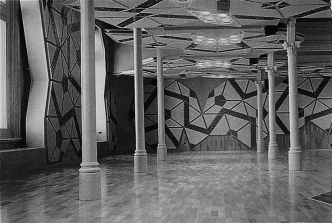Aperiodic
Tiling, Penrose Tiling and the Generation of Architectural Forms
Michael J.
Ostwald
University of Newcastle, AUSTRALIA
 "In
September 1995 the Australian architectural practice Ashton Raggatt
McDougall (ARM) invited the eminent mathematician Roger Penrose
to open their soon-to-be-completed refurbishment of the historic
Storey Hall complex of buildings at the Royal Melbourne Institute
of Technology. Penrose, who admitted that the design seemed "extremely
exciting", regretfully declined on the grounds that he was
already overcommitted to many projects to visit Australia at the
required time. He concluded his response to the invitation with
an enigmatic postscript which records that he is currently working
on "the single tile problem" and recently "found
a tile set consisting of one tile together with complicated matching
rule that can be enforced with two small extra pieces". This
postscript contains the first clue to understanding the mysterious
connection between Penrose and Storey Hall, between a scientist
and a controversial, award-winning, building.
"In
September 1995 the Australian architectural practice Ashton Raggatt
McDougall (ARM) invited the eminent mathematician Roger Penrose
to open their soon-to-be-completed refurbishment of the historic
Storey Hall complex of buildings at the Royal Melbourne Institute
of Technology. Penrose, who admitted that the design seemed "extremely
exciting", regretfully declined on the grounds that he was
already overcommitted to many projects to visit Australia at the
required time. He concluded his response to the invitation with
an enigmatic postscript which records that he is currently working
on "the single tile problem" and recently "found
a tile set consisting of one tile together with complicated matching
rule that can be enforced with two small extra pieces". This
postscript contains the first clue to understanding the mysterious
connection between Penrose and Storey Hall, between a scientist
and a controversial, award-winning, building.
Storey Hall is significant for
many reasons but only one prompted ARM to invite Penrose to open
it. The newly completed Storey Hall is literally covered in a
particular set of giant, aperiodic tiles that were discovered
by Roger Penrose in the 1970's and have since become known as
Penrose tiles. While architecture has, historically, always been
closely associated with the crafts of tiling and patterning, Storey
Hall represents a resurrection of that tradition.
But what is Penrose tiling and
what does it have to do with architecture in general and Storey
Hall in particular? This paper provides an overview of the special
properties and characteristics of Penrose's tilings before describing
the way in which they are used in ARM's Storey Hall. The purpose
of this binary analysis is not to critique Storey Hall or its
use of aperiodic tiling but to use ARM's design as a catalyst
for taking the first few steps in a greater analysis of Penrose
tiling in the context of architectural form generation."
Order the book Nexus II: Architecture
and Mathematics
| abstract
index | previous | next
| NNJ homepage | e-mail
Michael Ostwald | top of page
 "In
September 1995 the Australian architectural practice Ashton Raggatt
McDougall (ARM) invited the eminent mathematician Roger Penrose
to open their soon-to-be-completed refurbishment of the historic
Storey Hall complex of buildings at the Royal Melbourne Institute
of Technology. Penrose, who admitted that the design seemed "extremely
exciting", regretfully declined on the grounds that he was
already overcommitted to many projects to visit Australia at the
required time. He concluded his response to the invitation with
an enigmatic postscript which records that he is currently working
on "the single tile problem" and recently "found
a tile set consisting of one tile together with complicated matching
rule that can be enforced with two small extra pieces". This
postscript contains the first clue to understanding the mysterious
connection between Penrose and Storey Hall, between a scientist
and a controversial, award-winning, building.
"In
September 1995 the Australian architectural practice Ashton Raggatt
McDougall (ARM) invited the eminent mathematician Roger Penrose
to open their soon-to-be-completed refurbishment of the historic
Storey Hall complex of buildings at the Royal Melbourne Institute
of Technology. Penrose, who admitted that the design seemed "extremely
exciting", regretfully declined on the grounds that he was
already overcommitted to many projects to visit Australia at the
required time. He concluded his response to the invitation with
an enigmatic postscript which records that he is currently working
on "the single tile problem" and recently "found
a tile set consisting of one tile together with complicated matching
rule that can be enforced with two small extra pieces". This
postscript contains the first clue to understanding the mysterious
connection between Penrose and Storey Hall, between a scientist
and a controversial, award-winning, building.